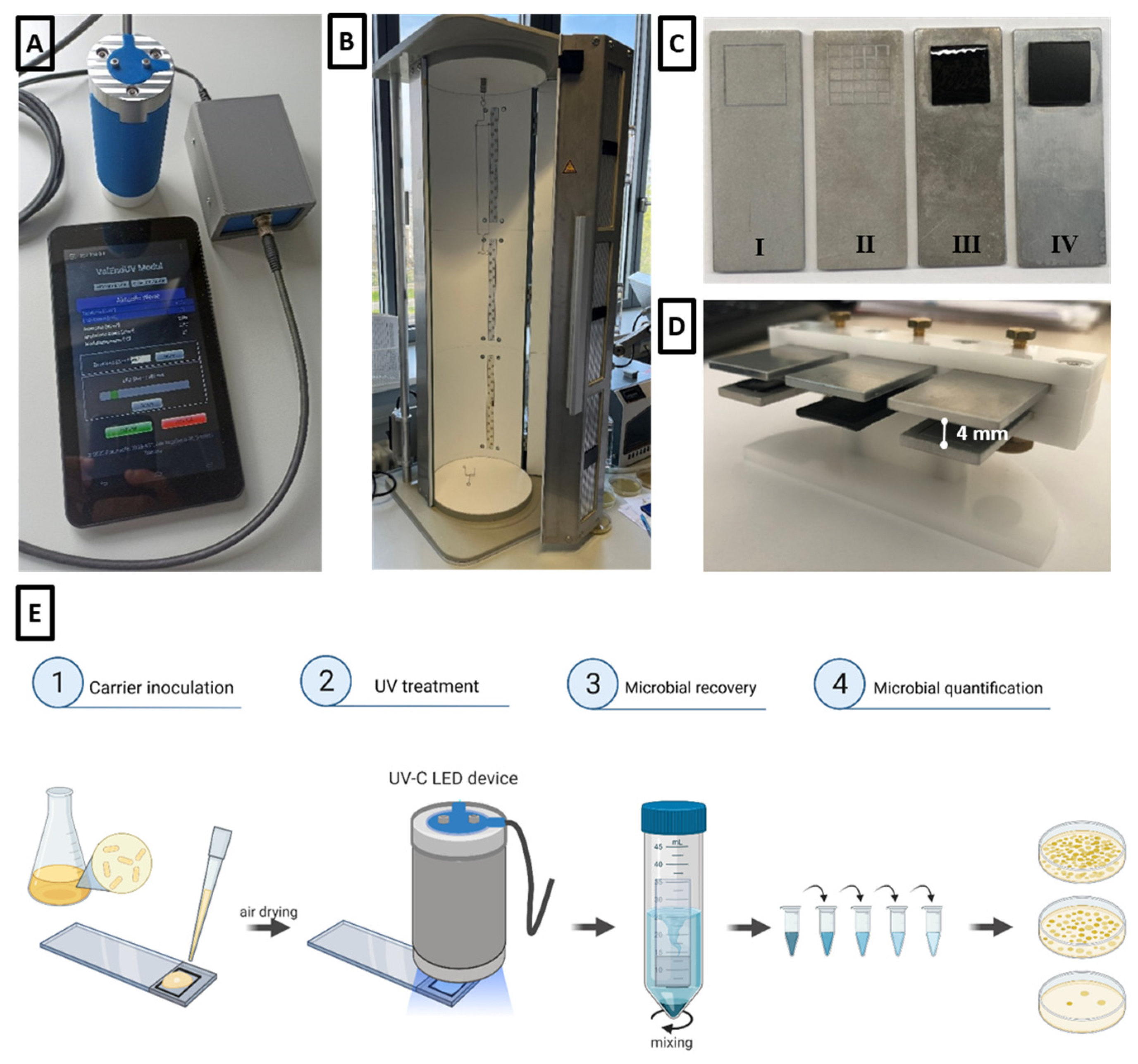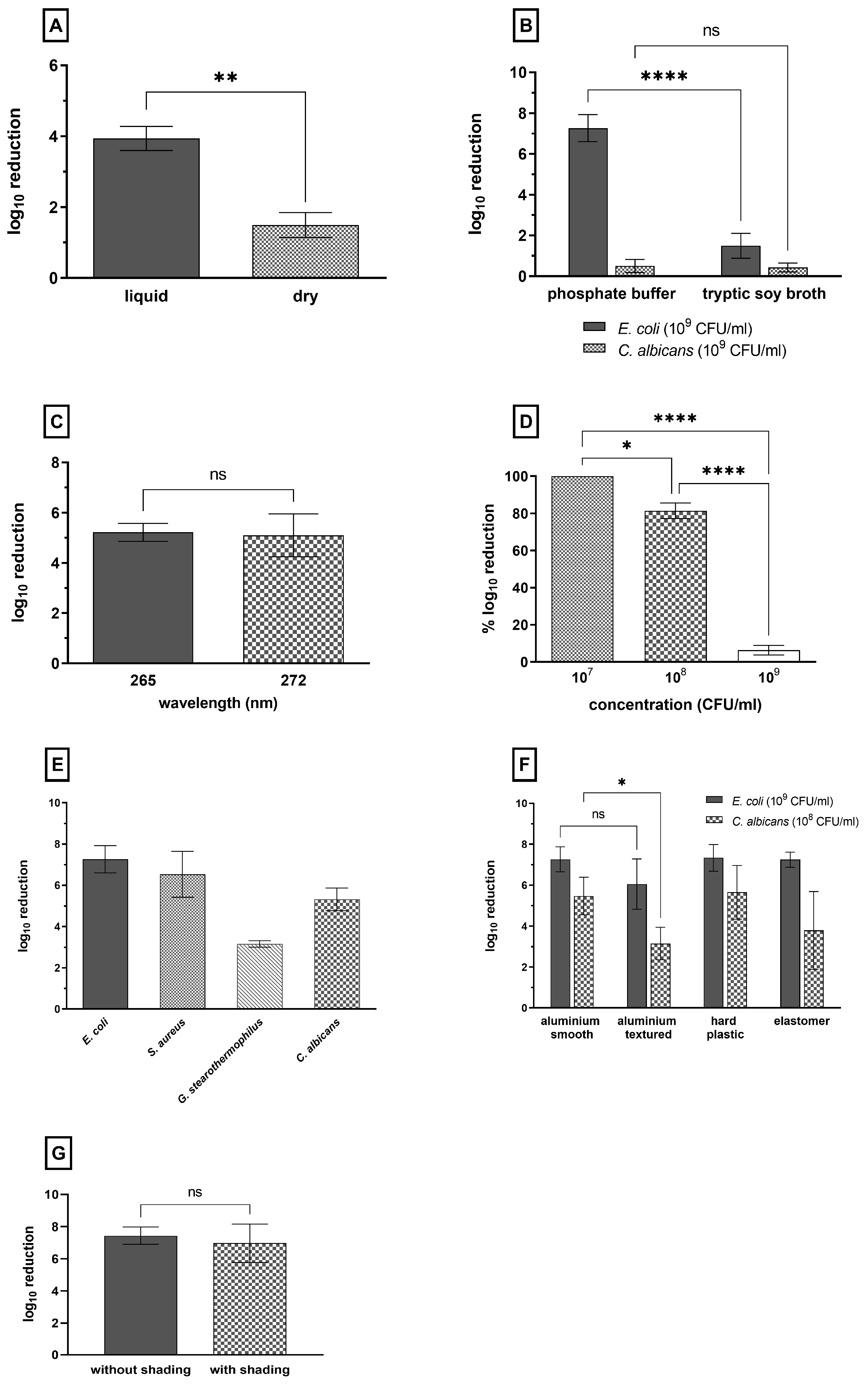Short-Wave Ultraviolet-Light-Based Disinfection of Surface Environment Using Light-Emitting Diodes: A New Approach to Prevent Health-Care-Associated Infections
Abstract
1. Introduction
2. Materials and Methods
2.1. Strains, Growth Conditions and Culture Preparation
2.2. UV-C LED Device
2.3. Carrier Preparation
2.4. Inoculation and UV Treatments
2.5. Microorganism Quantification and Reduction Calculation
2.6. Data Analysis
3. Results
3.1. Comparison of the Disinfection Efficiency of UV-C LEDs for Liquid and Dried Surface Samples
3.2. Influence of Surrounding Media and Nonmicrobial Contamination on the Disinfection Performance of UV-C Light
3.3. Comparison of Two Different Wavelengths in Regard to the Disinfection Efficiency of UV-C LEDs for E. coli on Surfaces
3.4. Influence of the Microbial Load on UV-C LED Disinfection Performance (C. albicans)
3.5. Effect of UV-C LED Irradiation on Different Microorganisms
3.6. Effect of UV-C LED Irradiation on Different Surfaces
3.7. Effect of Shading on UV-C Efficiency
4. Discussion
4.1. Comparison of the Disinfection Efficiency of UV-C LEDs for Liquid and Dried Surface Samples
4.2. Influence of Surrounding Media and Nonmicrobial Contamination on the Disinfection Performance of UV-C Light
4.3. Comparison of Two Different Wavelengths in Regard to the Disinfection Efficiency of UV-C LEDs for E. coli on Surfaces
4.4. Influence of the Microbial Load on UV-C LED Disinfection Performance (C. albicans)
4.5. Effect of UV-C LED Irradiation on Different Microorganisms
4.6. Effect of UV-C LED Irradiation on Different Surfaces
4.7. Effect of Shading on UV-C Efficiency
5. Conclusions
Author Contributions
Funding
Data Availability Statement
Acknowledgments
Conflicts of Interest
References
- World Health Organization. WHO Library Cataloguing-in-Publication Data Global Action Plan on Antimicrobial Resistance. Microbe Mag. 2015, 10, 354–355. [Google Scholar]
- Falguera, V.; Pagán, J.; Garza, S.; Garvín, A.; Ibarz, A. Ultraviolet processing of liquid food: A review: Part 2: Effects on microorganisms and on food components and properties. Food Res. Int. 2011, 44, 1580–1588. [Google Scholar] [CrossRef]
- Bintsis, T.; Litopoulou-Tzanetaki, E.; Robinson, R.K. Existing and potential applications of ultraviolet light in the food industry—A critical review. J. Sci. Food Agric. 2000, 80, 637–645. [Google Scholar] [CrossRef]
- Gayán, E.; Condón, S. Álvarez, I. Biological Aspects in Food Preservation by Ultraviolet Light: A Review. Food Bioprocess Technol. 2014, 7, 1–20. [Google Scholar] [CrossRef]
- Corrêa, T.Q.; Blanco, K.C.; Inada, N.; Hortenci, M.D.F.; Costa, A.A.; Silva, E.D.S.; Gimenes, P.P.D.C.; Pompeu, S.; Silva, R.L.D.H.E.; Figueiredo, W.M.; et al. Manual Operated Ultraviolet Surface Decontamination for Healthcare Environments. Photomed. Laser Surg. 2017, 35, 666–671. [Google Scholar] [CrossRef]
- Santos, T.D.; de Castro, L.F. Evaluation of a portable Ultraviolet C (UV-C) device for hospital surface decontamination. Photodiagn. Photodyn. Ther. 2021, 33, 102161. [Google Scholar] [CrossRef]
- Matin, A.R.; Yousefzadeh, S.; Ahmadi, E.; Mahvi, A.; Alimohammadi, M.; Aslani, H.; Nabizadeh, R. A comparative study of the disinfection efficacy of H2O2/ferrate and UV/H2O2/ferrate processes on inactivation of Bacillus subtilis spores by response surface methodology for modeling and optimization. Food Chem. Toxicol. 2018, 116, 129–137. [Google Scholar] [CrossRef]
- Chen, J.; Loeb, S.; Kim, J.-H. LED revolution: Fundamentals and prospects for UV disinfection applications. Environ. Sci. Water Res. Technol. 2017, 3, 188–202. [Google Scholar] [CrossRef]
- López-Malo, A.; Palou, E. Ultraviolet Light and Food Preservation. In Novel Food Processing Technologies; CRC Press: Boca Raton, FL, USA, 2004; pp. 405–421. [Google Scholar]
- Snowball, M.R.; Hornsey, I.S. Purification of Water Supplies Using Ultraviolet Light. In Development in Food Microbiology; Robinson, R.K., Ed.; Elsevier Applied Science: London, UK, 1988; pp. 171–192. [Google Scholar] [CrossRef]
- Gibbs, C. UV Disinfection; Soft Drink International: Wimborne, UK, 2000; pp. 32–34. [Google Scholar]
- Guerrero-Beltr·n, J.A.; Barbosa-C.·novas, G.V. Advantages and Limitations on Processing Foods by UV Light. Food Sci. Technol. Int. 2004, 10, 137–147. [Google Scholar] [CrossRef]
- Hoyer, O. Testing performance and monitoring of UV systems for drinking water disinfection. Water Supply 1998, 16, 419–442. [Google Scholar]
- Kim, T.; Silva, J.L.; Chen, T.C. Effects of UV Irradiation on Selected Pathogens in Peptone Water and on Stainless Steel and Chicken Meat. J. Food Prot. 2002, 65, 1142–1145. [Google Scholar] [CrossRef]
- Shama, G. Ultraviolet Light. In Encyclopedia of Food Microbiology (Second Edition); Batt, C.A., Tortorello, M.L., Eds.; Academic Press: Oxford, UK, 2014; pp. 665–671. [Google Scholar]
- Raeiszadeh, M.; Adeli, B. A Critical Review on Ultraviolet Disinfection Systems against COVID-19 Outbreak: Applicability, Validation, and Safety Considerations. ACS Photon. 2020, 7, 2941–2951. [Google Scholar] [CrossRef]
- Koutchma, T. Advances in Ultraviolet Light Technology for Non-thermal Processing of Liquid Foods. Food Bioprocess Technol. 2009, 2, 138–155. [Google Scholar] [CrossRef]
- Barancheshme, F.; Philibert, J.; Noam-Amar, N.; Gerchman, Y.; Barbeau, B. Assessment of saliva interference with UV-based disinfection technologies. J. Photochem. Photobiol. B Biol. 2021, 217, 112168. [Google Scholar] [CrossRef]
- Kim, D.-K.; Kim, S.-J.; Kang, D.-H. Bactericidal effect of 266 to 279 nm wavelength UVC-LEDs for inactivation of Gram positive and Gram negative foodborne pathogenic bacteria and yeasts. Food Res. Int. 2017, 97, 280–287. [Google Scholar] [CrossRef]
- Oteiza, J.M.; Giannuzzi, L.; Zaritzky, N. Ultraviolet Treatment of Orange Juice to Inactivate E. coli O157:H7 as Affected by Native Microflora. Food Bioprocess Technol. 2010, 3, 603–614. [Google Scholar] [CrossRef]
- Gabriel, A.A. Inactivation of Escherichia coli O157:H7 and spoilage yeasts in germicidal UV-C-irradiated and heat-treated clear apple juice. Food Control 2012, 25, 425–432. [Google Scholar] [CrossRef]
- Fredericks, I.N.; du Toit, M.; Krügel, M. Efficacy of ultraviolet radiation as an alternative technology to inactivate microorganisms in grape juices and wines. Food Microbiol. 2011, 28, 510–517. [Google Scholar] [CrossRef]
- Coohill, T.P.; Sagripanti, J.-L. Overview of the Inactivation by 254 nm Ultraviolet Radiation of Bacteria with Particular Relevance to Biodefense. Photochem. Photobiol. 2008, 84, 1084–1090. [Google Scholar] [CrossRef]
- Williams, B.L.; McCann, G.F.; Schoenknecht, F.D. Bacteriology of dental abscesses of endodontic origin. J. Clin. Microbiol. 1983, 18, 770–774. [Google Scholar] [CrossRef]
- Cadnum, J.L.; Shaikh, A.A.; Piedrahita, C.T.; Jencson, A.L.; Larkin, E.L.; Ghannoum, M.A.; Donskey, C.J. Relative Resistance of the Emerging Fungal Pathogen Candida auris and Other Candida Species to Killing by Ultraviolet Light. Infect. Control Hosp. Epidemiology 2018, 39, 94–96. [Google Scholar] [CrossRef] [PubMed]
- Sommers, C.H.; Sites, J.E.; Musgrove, M. Ultraviolet Light (254 nm) Inactivation of Pathogens on Foods and Stainless Steel Surfaces. J. Food Saf. 2010, 30, 470–479. [Google Scholar] [CrossRef]
- McGinn, C.; Scott, R.; Donnelly, N.; Roberts, K.L.; Bogue, M.; Kiernan, C.; Beckett, M. Exploring the Applicability of Robot-Assisted UV Disinfection in Radiology. Front. Robot. AI 2020, 7, 590306. [Google Scholar] [CrossRef] [PubMed]
- Cowan, T.E. Need for Uniform Standards Covering UV-C Based Antimicrobial Disinfection Devices. Infect. Control Hosp. Epidemiol. 2016, 37, 1000–1001. [Google Scholar] [CrossRef] [PubMed]


Disclaimer/Publisher’s Note: The statements, opinions and data contained in all publications are solely those of the individual author(s) and contributor(s) and not of MDPI and/or the editor(s). MDPI and/or the editor(s) disclaim responsibility for any injury to people or property resulting from any ideas, methods, instructions or products referred to in the content. |
© 2023 by the authors. Licensee MDPI, Basel, Switzerland. This article is an open access article distributed under the terms and conditions of the Creative Commons Attribution (CC BY) license (https://creativecommons.org/licenses/by/4.0/).
Share and Cite
Duering, H.; Westerhoff, T.; Kipp, F.; Stein, C. Short-Wave Ultraviolet-Light-Based Disinfection of Surface Environment Using Light-Emitting Diodes: A New Approach to Prevent Health-Care-Associated Infections. Microorganisms 2023, 11, 386. https://doi.org/10.3390/microorganisms11020386
Duering H, Westerhoff T, Kipp F, Stein C. Short-Wave Ultraviolet-Light-Based Disinfection of Surface Environment Using Light-Emitting Diodes: A New Approach to Prevent Health-Care-Associated Infections. Microorganisms. 2023; 11(2):386. https://doi.org/10.3390/microorganisms11020386
Chicago/Turabian StyleDuering, Helena, Thomas Westerhoff, Frank Kipp, and Claudia Stein. 2023. "Short-Wave Ultraviolet-Light-Based Disinfection of Surface Environment Using Light-Emitting Diodes: A New Approach to Prevent Health-Care-Associated Infections" Microorganisms 11, no. 2: 386. https://doi.org/10.3390/microorganisms11020386
APA StyleDuering, H., Westerhoff, T., Kipp, F., & Stein, C. (2023). Short-Wave Ultraviolet-Light-Based Disinfection of Surface Environment Using Light-Emitting Diodes: A New Approach to Prevent Health-Care-Associated Infections. Microorganisms, 11(2), 386. https://doi.org/10.3390/microorganisms11020386





